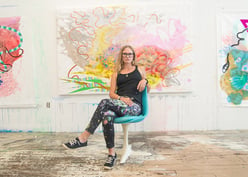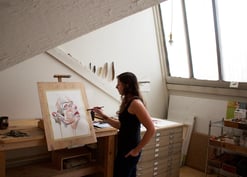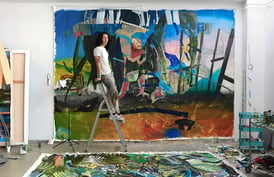TurningArtist Warren Keating works quickly, full of energy and focus. With rapid mark-making and thick brush strokes, Keating creates aerial portraits of unsuspecting subjects. His works are the result of collecting photographs and videos of unwitting subjects from above, painstakingly selecting the exact frame that tells a particular story, and then painting that image. Keating has always been interested in incorporating new technology in his work so the marriage of traditional oil painting and digital video excites him.
He hopes that the unique aerial viewpoint of his work helps the viewer gain a new perspective and rediscover the beauty and poetry in the everyday moments.
Can you tell us about your journey to become a professional artist?
I have been drawing and painting since I was a child and always knew that I was an artist. I spent many years working as an Art Director, photographer, and videographer until the internet changed my life. I started selling my work online 12 years ago and, after a couple of years, was able to quit my corporate job as an art director and become a full-time artist. As my online presence increased, I received more and more email inquiries for exhibit opportunities, commissioned work and corporate collections. These possibilities further helped grow my career and reputation. I primarily sold work online until about four years ago when I moved to Santa Fe and became represented by ViVO Contemporary on renowned Canyon Road. Now my time is divided between selling my work in both online and brick-and-mortar galleries. I have learned how to give lectures and write about my work, skills that are crucial for advancing one’s art career. I love connecting with new collectors or fans whenever possible.
How would you describe your paintings?
I started this series accidentally. I had been painting and exhibiting a series of landscapes of the coast of Oaxaca across Mexico when, while on vacation in Paris with my wife, I began playing with a new video camera that I had just bought. There was a consulate across the street, and I filmed people going in and out of it. Several months later in the studio, I printed out some still frames from the video and used them as reference for a couple of new paintings. At first, I was “finishing” the images with smooth contours and details that were not in the video still frame images, but then I started experimenting with using some of the distortion and motion artifacts in the reference video and began the process of developing the Pixel Impressionism style that you see in my current paintings.
I use the foreshortened, above view combined with my signature Pixel Impressionism style to create a new form of the contemporary figurative painting: a new Impressionism for the 21st Century.
During my teenage years, I was crippled from a congenital disease and was unable to walk for several years. I think this experience has contributed to my obsession with walking.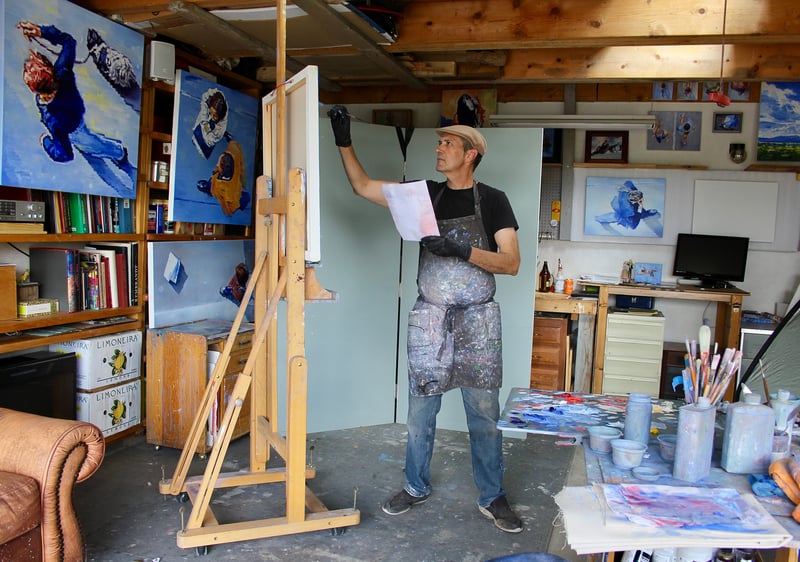 Can you tell us about your process for creating a new painting?
Can you tell us about your process for creating a new painting?
My painting process starts with gathering video footage from bridges and balconies of unsuspecting people walking below me. I started with a 420p video camera but, over the years, I've evolved to use iPads and GoPros and currently I am implementing a drone to capture my reference video. I view the collected video on my computer, advancing it frame-by-frame until I capture a still frame of the pedestrian at the perfect moment of weight shift or arm thrust. In my Santa Fe Studio, I feverishly paint from the reference, wet-in-wet with oils on stretched canvas; I have to finish the piece before it begins to dry to get the motion and texture of my signature style. I strive to create an expressive, but recognizable image. I am inspired to make figurative painting relevant in a 21st Century context, so I have developed this process and my unique mark-making to that end.
When looking for inspiration, what resources do you turn to?
I either go out and get new video or spend hours combing through the 1000’s of videos that I have already collected of people walking in Los Angeles, Paris, New York, New Orleans, and Santa Fe. Since moving to Santa Fe from Los Angeles, I have had to adopt new technologies to compensate for the lack of tall buildings here. To that end, I have been implementing drones to gather new reference video and have been searching out places where Southwest activities abound. I still stay true to my popular motifs of people walking in cities, but I have definitely been working on a whole new series of Southwest-inspired figurative paintings.
Walk us through a typical day in your studio. What is your routine?
I live very close to walking paths, which are my current inspiration, so I start early in the morning, flying my drone over the paths at 7 am to catch an early morning walker, or, even better, a dog walker. Then, in my studio, on “painting days” (days that I am not collecting reference of going through footage on the computer) I start as early as possible, so I can finish the piece before it starts to dry, as required by my “wet-in-wet” process. In summer, I have until the end of the day before the oil paint mixed with linseed oil starts to set. In winter, I can let my studio get very cold at night, and I have two and a half days to complete the piece before the surface starts to harden.
I try to stay perfectly focused and active while painting. I listen to music the entire time, taking short “dance breaks” in between brush strokes. I have to keep the vibe in the studio focused and high energy, and playing music and dancing keeps that vibe going. I often paint for 12-14 hours and the application of paint must be direct, active and focused the entire time. If I make a “lazy” or “unfocused” mark, I cover it up with one that has energy and focus.
I have experimented with projecting the images onto the canvas, instead of painting them freehand, but my work only has dynamic energy when I work freehand from photo reference. “Finding” the image on the canvas while painting gives an expressive, dynamic look to the piece that I cannot achieve by projecting and tracing the image.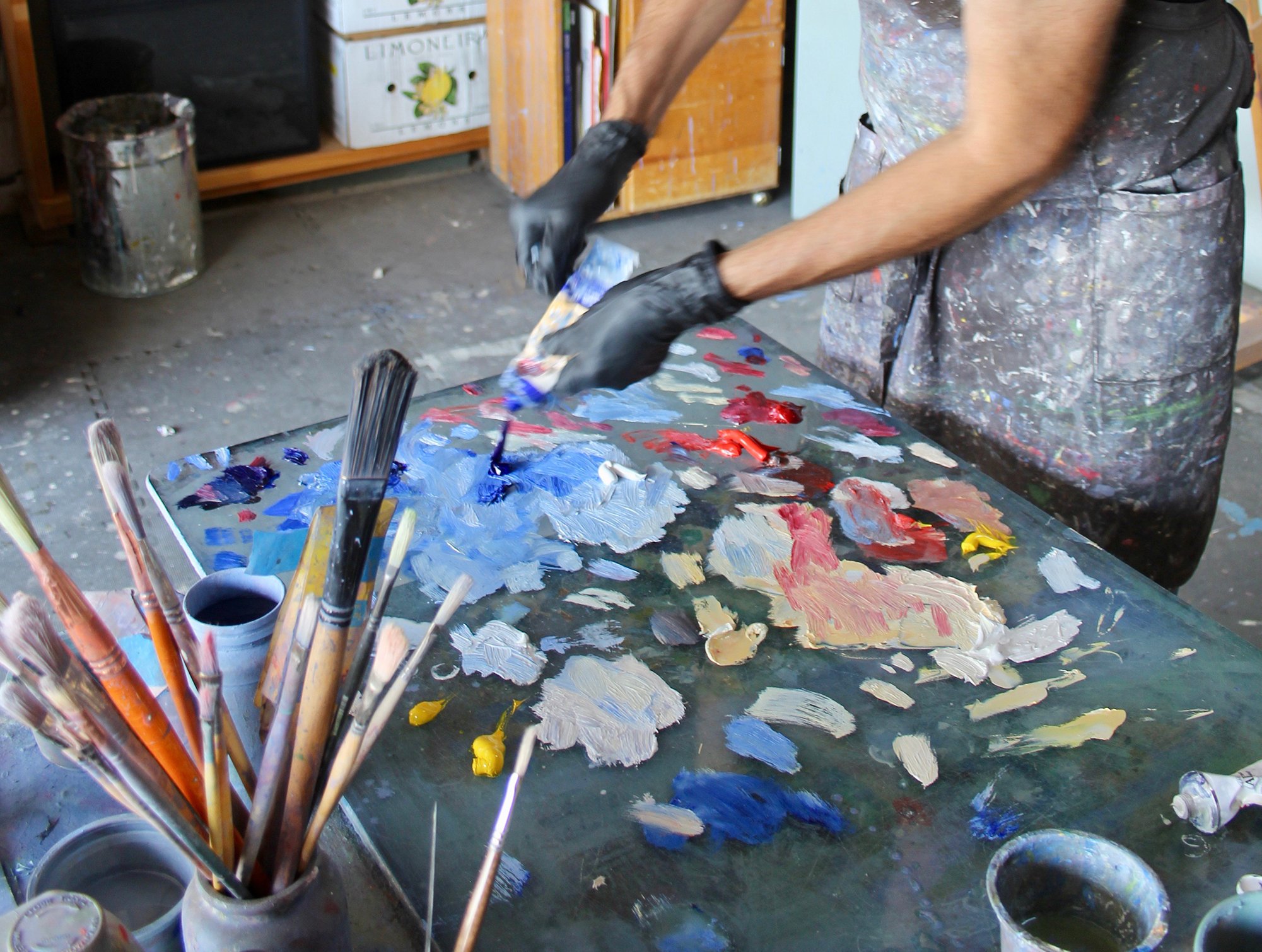
For emerging artists, finding the right rhythm to be productive in the studio can be a challenge, what advice do you have for staying productive and focused?
It helps me to start early in the day with a solid plan. I make any possible preparations the night before, like masking the sides of the canvas, so I can start painting first thing. When doing figurative painting, one has to balance the need to illustrate with the necessity that every mark must be an integral part of the painting in an abstract sense. This involves being aware and open to happy accidents, marks or paint effects that don’t follow the illustrated form but work in the painting as an abstract element. Knowing when to correct these “mistakes” and when to leave them in the final painting is one of the biggest challenges. I guess the goal is to become completely lost in creating the painting to achieve a greater awareness of what is happening in the painting.
What is your advice for combating creative block?
I never have creative block, but when I have some semblance of that, I just make a painting with the intent that it is expendable. Sometimes that means to make a painting that doesn’t follow my regular process, maybe I paint more aggressively or don’t worry about making it as anatomically correct as I usually do. I sometimes have to think “this is just a painting that I will destroy; it doesn’t matter” to get to that point where I am more open to the next stage of evolution in my work.
As an artist, how do you measure your success?
One of the biggest measures of success for me was becoming a full-time artist. Being able to support my family by selling my work was only a fantasy for many years, but now I am very grateful it is my reality. I do not work in a vacuum, so when I make a sale, I can’t help but be validated by that moment when someone connects enough with my art to allow it into their home or office. Some artists may think that I am too sales-oriented, but it’s really the connection made between the collector and the work that makes me feel good, not the commerce part. That said, selling my work consistently does allow me to make more of it and live the “artist’s life”, so I am very thankful that I sell so much.
Additionally, my first solo show in Los Angeles was a big event in my career and having my art placed in corporate collections by TurningArt also makes me feel successful, but the biggest measure is how my process is developing. Is it evolving? Is it unique? Is it true contemporary pictorial form? Have I invented something? These are the nagging questions the drive me to create. When someone comments that I have invented a style after their first encounter with my work, it is pretty much the highest compliment they can give me.

How do you see the art market changing? Where you do see yourself in this transition?
When I started offering my work for sale online 12 years ago, I benefited greatly from being on the cutting edge, one of the few artists offering contemporary figurative paintings for sale online. I try to remember that and stay one step ahead of the crowd in how I market and sell my work.
The traditional art market is changing mostly due to the rise of the online art market. There is a move to more transparency in the art-buying and collecting process and a move away from too many middlemen in between the artist and collector. I still think the traditional gallery has an important place in selling art, but the more that the dealer, artist, and collector can work together with a greater degree of transparency, the more the brick-and-mortar art market will expand.
The online art market has also given access to new generations and types of collectors. I find this to be a growth area in the market, so I strive to educate and otherwise give increased access to these new collectors. I find it important to communicate my story, my inspiration and the uniqueness of my process to the art-buying public. People don’t always trust their instincts when making a purchase decision, so supplying them with the story behind the art helps give them permission to buy what they like.
Do you consider yourself, and all artists, to be entrepreneurs?
Artists that are managing their own careers are entrepreneurs. We have to figure out ways to present, market, package, and ship our artworks globally. Not all artists manage their own careers that way, they surrender all of that control over their careers to the gallery, and that works for them, but they are not entrepreneurs in the sense that an artist that manages his or her own career is.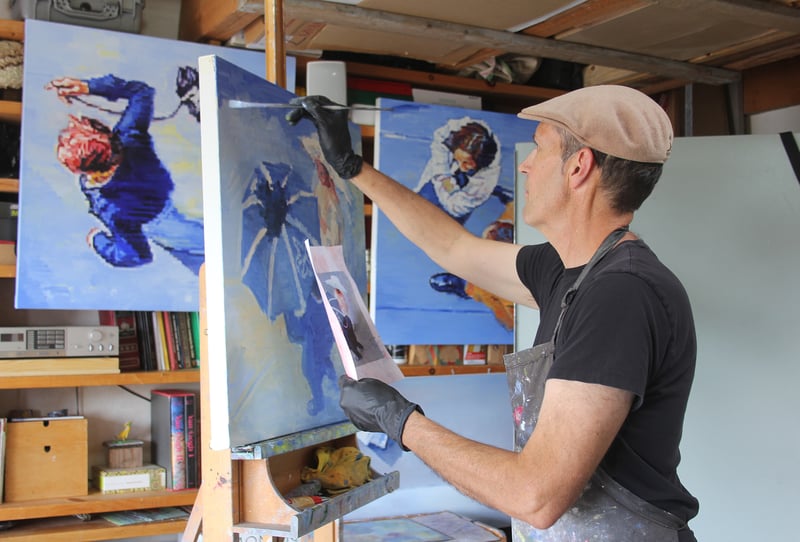 Failure is an inevitable part of success in any field. Do you have advice for overcoming setbacks?
Failure is an inevitable part of success in any field. Do you have advice for overcoming setbacks?
There are two kinds of setbacks that I have experienced - artistic and career. Artistic setbacks are better handled when the artist believes the individual work is inconsequential and knows that the lifelong development of his or her process is the end game. I liken an artist’s process to making a roast and the individual works as gravy. The artist’s goal is to make a beautiful roast, that is his or her lifelong process. Occasionally, the artist will pull a finished work from that process like scooping gravy from the pan.
What sparked your interest in partnering with TurningArt?
I was one of the first artists to partner with TurningArt many years ago. I made that decision solely based on the fact that I thought it was one of the coolest things I had heard of, their Netflix-style print rental service. After they modified their business model a bit, the relationship started to provide a financial benefit, but the overriding factor was that I really liked their unique business model. Now, TurningArt has made me some substantial revenue and placed my art in some impressive corporate environments, so I couldn’t be happier with our partnership. Also, the TurningArt staff is a joy to work with.
TurningArt simply has a very unique business model and way of doing business. I haven’t worked with any other art companies that are even remotely similar.
What does having your artwork in the workplace and other commercial or public spaces mean to you?
I feel that my aerial perspective figurative paintings depicting people walking lend themselves to public spaces. It’s wonderful to experience the connection between art and collector, but it is also a fantastic feeling when your art gets seen by multitudes every day, day after day. I love it when one of my friends is visiting a building they’ve never been to before, and they are surprised by one of my paintings in the lobby.
To see more featured TurningArtists, return to our blog. To get Warren Keating's art in your space, set up a free consultation with an Art Advisor here!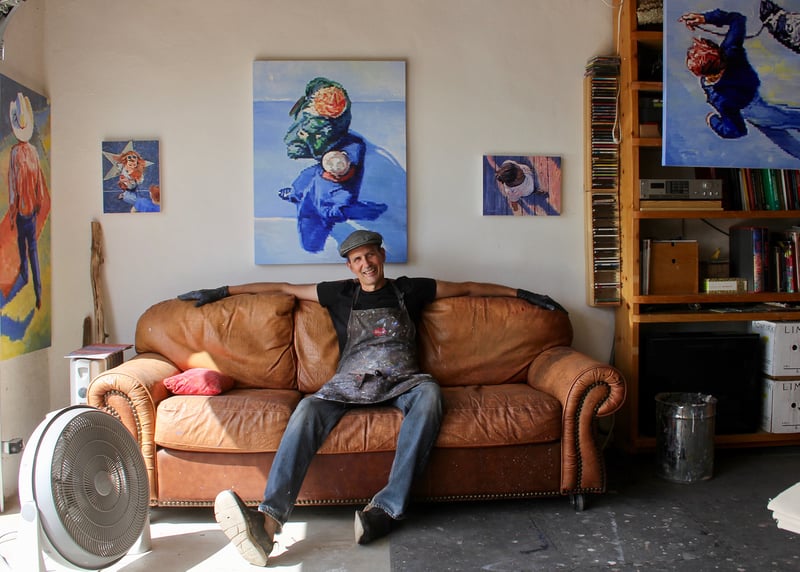
_VSCO.jpg?width=332&height=177&name=TMoss_Continuum%20Sliver%20copy%20(1)_VSCO.jpg)
